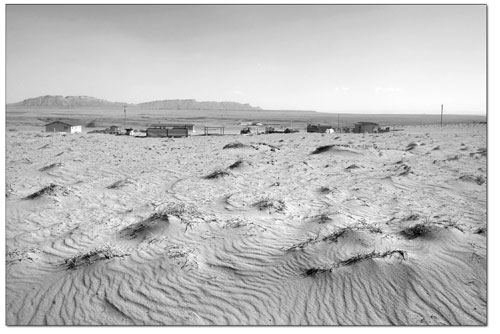|
| ||
| Piping into the Navajo Nation
by Will Sands The Animas-La Plata project’s big brother appears to be taking shape downstream. The Navajo-Gallup water supply project, a new Four Corners water project that would dwarf A-LP both in finances and infrastructure, is forging ahead. Last week, the proposed pipeline landed in the U.S. Congress in search of funding, but the massive project is also gathering opposition along the way. Late in 2003, the Navajo Nation and the U.S. government reached an agreement on water rights owed to the tribe. The gist of the settlement was that the Navajo Nation would agree to limit its share of San Juan River water to 322,000 acre-feet per year with no future claims and drop a lawsuit asserting Navajo claims to San Juan Basin water, which has been in the courts since 1975. Nearly $900 million in federal funding for infrastructure would be given to the tribe in exchange for the settlement. By comparison, A-LP, just south of downtown Durango, is a 120,000 acre-foot project with a current cost estimate of $500 million. The majority of the funding for the Navajo project would go to the construction of an elaborate pipeline that would siphon water out of the San Juan River in the vicinity of Shiprock and feed the eastern side of the reservation. As proposed, the pipeline would take as much 180 cubic feet of the San Juan per second in order to provide drinking water to as many as 250,000 people by the year 2040. The agreement also includes details of how water would be delivered to the pipeline from Bureau of Reclamation water projects including Navajo Reservoir and the Animas-La Plata project. Navajo Nation President Joe Shirley. Jr. and Gallup Mayor Bob Rosebrough have both argued that the pipeline is badly needed on the impoverished Navajo Nation. “This settlement is crucial to the Navajo Nation,” Shirley said. “It is vital that people see the conditions that some of our people are living in right now. There are people in America without running water. This is one of the primary reasons why we need to move forward with this water project.” Rosebrough added that the water table is receding in areas of northwest New Mexico. “Our current water supply will be depleted in 15 years, and many Navajos who do not have tap water in their homes come to our municipal water points to get water for household use,” he said. “Up until now, there was real uncertainty for our city’s future.” Last week, the Navajo pipeline went to the next level, when Sen. Jeff Bingaman, D-N.M., introduced a bill asking the Senate to approve the Navajo settlement and effectively allocate the water rights and award the funding. U.S. Rep. Tom Udall, D-N.M., introduced parallel legislation in the House of Representatives. “The settlement is a bold step to address the need for a water system in this area of New Mexico and will have far-reaching benefits to multiple communities,” Bingaman said. “It gives this region security and a way to pursue economic development to remain a viable region in the state – all the while ensuring that these communities’ children and grandchildren will have access to a reliable source of clean water.” However, numerous other parties, including long-time opponents of the Animas-La Plata project, are taking a different view of the settlement. Phil Doe, Chair of the Citizens’ Progressive Alliance, said the agreement could spell trouble for the Four Corners area and the San Juan and Animas rivers. Among other things, the project would dewater the San Juan, including the permitted river trip sections, is a thinly veiled attempt to open the door to new Four Corners power plants and would reverse efforts to aid endangered fish, according to the CPA. Doe, a former Bureau of Reclamation employee, added that the project fails to make physical or financial sense. “How they’re going to get the water down to these hogans and why it should cost $1 billion are both beyond me,” he said. “I’m not opposed to the Navajos having a water supply but it has to be within the realm of reason.” Doe also contended that there is not sufficient water in the San Juan River to feed the ambitious project. At 180 cubic feet per second, every day and all year, the project would cut into New Mexico’s and Arizona’s existing shares of the river, according to Doe. With that in mind, the project might even have to look upstream to Colorado, which could impinge on Animas River water rights. “There is no water for this project right now,” Doe said. “The water would have to come out of New Mexico’s and Arizona’s shares of the Colorado River or it would have to come from Colorado. The government should be doing some kind of assessment on how much water’s left in the river and who owns it.” With Congress now considering whether to approve the settlement and ultimately fund the pipeline, the CPA is going to be keeping a close eye on the project. That said, Doe noted that the circumstances remain vague. “They don’t have any funding yet,” he said. “They don’t have a credible environmental impact statement. What can you do? I’m all for the Navajos getting what water they have coming, but it has to be after a rigorous examination of alternatives.” •
|


